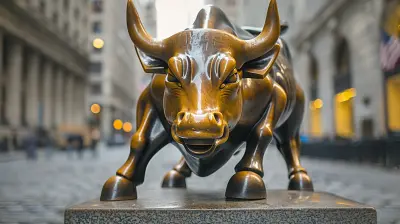Why Time in the Market Beats Timing the Market
29 July 2025
Investing can feel like a rollercoaster ride. The stock market goes up, then down, then sideways, and it’s tempting to try and jump in at the perfect moment. But here’s the truth—trying to time the market is almost always a losing game. Instead, staying invested for the long haul tends to be the smartest strategy.
If you’ve ever wondered whether you should wait for the "right time" to invest, this article is for you. We'll break down why time in the market beats timing the market, using real-world examples, logic, and a touch of common sense. 
The Illusion of Market Timing
Market timing sounds great in theory—buy low, sell high, and make a fortune. Simple, right? Not quite.Even professional investors struggle to time the market consistently. For the average person, trying to predict short-term market movements is like throwing darts in the dark. The market moves based on countless factors—economic data, corporate earnings, global events, and even investor emotions—and no one can predict all of them correctly every time.
Missing the Best Days Can Crush Your Returns
One of the biggest dangers of trying to time the market is missing the best days. A handful of strong days often contribute significantly to long-term gains, and unfortunately, those days are nearly impossible to predict.Consider this:
- A study by J.P. Morgan found that if an investor missed the 10 best days in the market over a 20-year period, their returns would be cut in half.
- Missing the 30 best days? That investor might barely beat inflation.
The kicker? Many of the market's best days happen right after the worst days. If you panic and sell during a downturn, you might miss out on the quick rebound that follows. 
The Power of Time in the Market
Instead of trying to predict the market's next move, smart investors focus on staying invested. Let’s look at why long-term investing wins.1. Compound Growth Works Wonders
Albert Einstein reportedly called compound interest the "eighth wonder of the world." The longer you stay in the market, the more time your investments have to grow—and the more powerful compounding becomes.Imagine investing $10,000 in an index fund that averages an annual return of 8%.
- After 10 years, it grows to about $21,600.
- After 20 years, it’s about $46,600.
- After 30 years, it balloons to $100,600!
The key takeaway? The sooner you start, the more time your money has to compound.
2. Markets Trend Up Over the Long Term
Yes, the stock market has short-term ups and downs. But history shows that over extended periods, it generally moves upward.Take the S&P 500 as an example. Despite crashes, recessions, and global crises, it has historically delivered an average annual return of around 7-10%. If you zoom in on any short period, you might see volatility. But stretch the timeline, and you see steady growth.
This means that even if you invest during a downturn, history suggests you’ll benefit as long as you stay in the market.
3. Eliminating Emotional Mistakes
Fear and greed are the biggest enemies of investors. When the market crashes, fear pushes investors to sell. When it soars, greed tempts them to buy more at inflated prices. This emotional cycle often leads to poor decision-making.By committing to long-term investing, you avoid the emotional rollercoaster and stick to a strategy that actually works. 
Historical Evidence That Proves the Point
Let’s look at some real-world examples to reinforce why time in the market is superior to timing the market.The Great Financial Crisis (2008-2009)
When the market crashed in 2008, many investors panicked and sold their stocks. But those who stayed invested saw their portfolios recover and grow substantially in the following years.- If you invested $10,000 in the S&P 500 at the market peak in 2007, your portfolio would have dropped by over 50% during the crash.
- However, if you held on, by 2013, you would have completely regained your losses—and by 2021, your investment would have more than tripled.
The COVID-19 Market Crash (2020)
In March 2020, the stock market experienced a rapid crash due to pandemic fears. Many investors sold in panic. But just a few months later, the market rebounded and reached new highs.- Those who stayed in the market saw enormous gains.
- Those who sold had to decide when to get back in—often missing the best recovery days.
These examples reinforce that the market rewards patience much more than panic-driven decisions. 
A Smarter Approach: Dollar-Cost Averaging
If you're worried about when to invest, dollar-cost averaging (DCA) can be your best friend.What Is Dollar-Cost Averaging?
DCA involves investing a fixed amount of money at regular intervals, regardless of market conditions. For example, you might invest $500 every month into an index fund.Why It Works:
- It removes emotions from investing.- You buy more shares when prices are low and fewer when they’re high.
- It smooths out volatility over time.
This strategy ensures you're always investing—without the stress of trying to guess market movements.
The Bottom Line
The secret to successful investing isn’t about predicting the market’s next move—it’s about staying in the game.- Timing the market can lead to costly mistakes.
- Time in the market allows your investments to compound and grow.
- The market’s long-term trend is upward, despite short-term turbulence.
- Strategies like dollar-cost averaging can make investing easier and stress-free.
So, instead of waiting for the "perfect time" to invest, start now. Your future self will thank you.
all images in this post were generated using AI tools
Category:
Financial LiteracyAuthor:

Harlan Wallace
Discussion
rate this article
1 comments
Tilly Murphy
Great insights! Consistency truly outweighs short-term guesses.
August 28, 2025 at 4:46 AM

Harlan Wallace
Thank you! I completely agree—consistent investing is key to long-term success.


